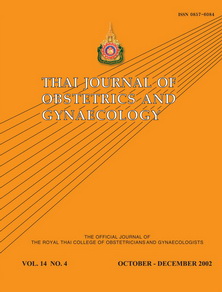Comparison of The Survival Rate between Squamous Cell Carcinoma and Adenocarcinoma of the Uterine Cervix
Main Article Content
Abstract
Objective To compare the survival rate between squamous cell carcinoma (SCC) and
adenocarcinoma (ACA) of the uterine cervix.
Methods All medical records and pathological reports were reviewed. The patients who lost to follow up were contacted by telephone, mail, or computerized death data from local registration sector at BMA.
Results Five hundred and seventy three patients were studied. SCC, the most common
histologic type, was found in 79.23%. ACA including adenosquamous cell carcinoma and
other subtypes consisted of 20.77%. The mean age in ACA group was 47.85 + 10.99 years
which was significantly lower than 51.15 + 11.87 years of SCC group (p=0.006). Most patients
(65.9%) with SCC had tumor grade II but patients with ACA were commonly found in grade
III(42.0%). Regarding clinical presentation, ACA was found at earlier stages than SCC
(p<0.0001). About half of these patients with ACA had tumor characteristics as exophytic
mass(56.7%) whereas tumor of patients with SCC were mainly ulceroinfiltrative lesion(56.2%).
With the median follow up time of 51 months(range 0 – 110 months), the overall survival of
SCC was 61.34% and ACA was 62.27%(p =0.7467). Comparing the survival of SCC and ACA,
stage by stage, ACA had poorer survival rate in every stage, with no statistically significant
difference.
Conclusion SCC was the most common cell type in cervical carcinoma. The patients with SCC were older, and presented at more advanced stage than patients with ACA. The overall
survival of patients with both cell types were not significantly different.
Article Details

This work is licensed under a Creative Commons Attribution-NonCommercial-NoDerivatives 4.0 International License.
References
The National Cancer Institute Annual report,1997. Available from: URLhttp://www.nci.go.th/statisti.htm.
Hopkins MP, Morley GW. A comparison of adenocarcinoma and squamous cell carcinoma of the cervix. Obstet Gynecol 1991; 77: 912–7.
Chen RJ, Lin YH, Chen CA, Huang SC, Chow SN, Hsieh CY. Influence of histologic type and age on survival rates for invasive cervical carcinoma in Taiwan.Gynecol Oncol 1999; 73 : 184–90.
Anton CH, Bloss JD, Bringman DD, Lee FA, Disaia P, Manetta A.Comparison of adenocarcinoma and squamous cell carcinoma of the uterine cervix : a population – based epidemiological study. AmJ Obstet Gynecol 1992; 166 : 1507–14.
Shingleton HM, Bell MC, Fremgen A, Chmiel JS, Russell AaH, Jones WB.et al. Is there really a difference in survival of women with squamous cell carcinoma, adenocarcinoma, and adenosquamous carcinoma of the cervix ? Cancer 1995; 76 : 1948–55.
Randall ME, Constable WC, Hahn SS, Kim JA, Mills SE. Results of the radiotherapeutic management of carcinoma of the cervix with emphasis on the influence of histologic classification.Cancer 1988; 62 : 48–53.
Kilgore LC, Soong SJ, Gore H, Shingleton HM, Hatch KD, Partridge EE. Analysis of prognostic features in adenocarcinomas of the cervix. Gynecol Oncol 1988;31 : 137–48.
Benedet JL, Pecorelli S. FIGO Special Report on Gynecologic Cancer : International Journal of Gynecologic & Obstetrics 2000;70 :221-9.
Herbert A, Singh N, Smith JAE. Adenocarcinoma of the uterine cervix compared with squamous cell carcinoma : a 12-year study in Southamton and South- west Hampshire Cytopathology 2001; 12 : 26–33.
Silcocks PBS, Thornton JH, Murphy M. Squamous and adenocarcinoma of the uterine cervix : A comparison using routine data. Br J Cancer 1987; 55 : 321–5.
Smales E, Perry CM, Ashby MA, Baker JW. The influence of age on prognosis in carcinoma of the cervix. Br J Obstet Gynaecol 1987; 94 : 784–7.
Ashby MA, Smales E. Invasive carcinoma of the cervix in young women : clinical data. Radiother Oncol 1987;10:167–74.
Brewster WR, Disaia PJ, Monk BJ, Ziogas A, Hamada SD, Anton CH. Young age as a prognostic factor in cervical cancer : results of a population – based study. Am J Obstet Gynecol 1999; 180 : 1464–7.
Chen RJ, Chang DY, Yen ML, Lee EF, Huang SC, Chow SN et al. Prognostic factor of primary adenocarcinoma of the uterine cervix. Gynecol Oncol 1998 ; 69 : 157–64.
Saigo PE, Cain JM, Kim WS, Gaynor JJ, Johnson K, Lewis JL Jr. Prognostic factors in adenocarcinoma of the uterine cervix. Cancer 1986; 8 : 1584-93.
Kjorstad KE. Adenocarcinoma of the uterine cervix. Gynecol Oncol 1977; 5 : 219–23.

